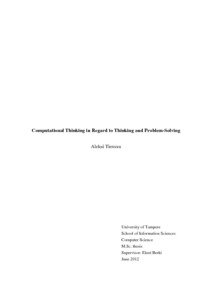Computational Thinking in Regard to Thinking and Problem-Solving
TIENSUU, ALEKSI (2012)
TIENSUU, ALEKSI
2012
Tietojenkäsittelyoppi - Computer Science
Informaatiotieteiden yksikkö - School of Information Sciences
This publication is copyrighted. You may download, display and print it for Your own personal use. Commercial use is prohibited.
Hyväksymispäivämäärä
2012-06-13
Julkaisun pysyvä osoite on
https://urn.fi/urn:nbn:fi:uta-1-22704
https://urn.fi/urn:nbn:fi:uta-1-22704
Tiivistelmä
Computational thinking is a relatively new concept that is still looking for its exact definition. It can be seen as the by-product of exposure to computational activities, as well as collection of information processing tools one is familiarized with through computing. However, it can be a lot more than that. Similarly as mathematical thinking can be seen to be the constructive force behind mathematics, computational thinking can be seen as the driving force behind computing. Computational thinking is approached via what is known of thinking and problem-solving. The aims of the study are to further clarify the concept and to figure out how thinking and problem-solving can be affected by the acquisition of computational thinking, and to look into if there is anything that can be done to produce more efficient computational thinkers (e.g., programmers and software developers).
The research reveals that computational thinking has notable potential to improve the “general” thinking and problem-solving ability, but there are barriers that have to be dealt with in order to meaningfully benefit from this potential. These barriers rise from the nature of thinking and they cannot be completely bypassed. However, the thesis provides methods of how to handle them more effectively.
Asiasanat:computational thinking, thinking, problem-solving, learning
The research reveals that computational thinking has notable potential to improve the “general” thinking and problem-solving ability, but there are barriers that have to be dealt with in order to meaningfully benefit from this potential. These barriers rise from the nature of thinking and they cannot be completely bypassed. However, the thesis provides methods of how to handle them more effectively.
Asiasanat:computational thinking, thinking, problem-solving, learning
